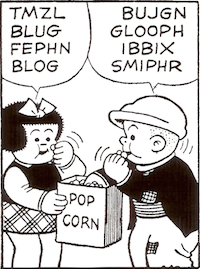One of the strangest and best episodes of Naked City I’ve seen: “Hold for Gloria Christmas” (first aired September 19, 1962), an unusually respectful look at Beat culture, as found in New York’s Greenwich Village. The episode tells the story of Duncan Kleist (Burgess Meredith), an alcoholic poet determined to recover the manuscripts he’s traded to bar owner Stanley Dorkner (Herschel Bernardi). Kleist (who shares a last name with a German poet) seems a cross between Jack Kerouac and Dylan Thomas — disheveled, sweaty, tossing off what seem to be spontaneous bits of eloquence. Dorkner kills Kleist in the opening minutes of the episode; as the detectives investigate, flashbacks give us the events that precede the opening scene.
The opening gives us a quick tour of West Fourth Street locations. Click on any image for a larger view.

[Duncan Kleist, running with an envelope full of manuscripts.]
The Music Inn still stands at 169 West Fourth. It’s now an instrument store. Here’s a short video about the store’s history.

 Bill Tendler? A jeweler (1906–1973). Here are some samples of his work. The Village Voice ad to the left appeared on December 7, 1955. I don’t know who occupied no. 169 when.
Bill Tendler? A jeweler (1906–1973). Here are some samples of his work. The Village Voice ad to the left appeared on December 7, 1955. I don’t know who occupied no. 169 when.

[Kleist stops to talk to a blind newsvendor.]
At 171 West Fourth, Allan Block Sandals. Here is a brief chronology of Block’s life. As the musicologist Elijah Wald has noted, Block’s shop was “the unofficial headquarters of the old-time string band revival.” Block’s daughter, the musician Rory Block, has written about her family’s life on Fourth Street. And Allan, who left New York for New Hampshire, may be found fiddling on YouTube.

[From David Hajdu’s Positively 4th Street: The Lives and Times of Joan Baez, Bob Dylan, Mimi Baez Farina and Richard Fariña (2001).]

Bianchi & Margherita, at 186 West Fourth, was an Italian restaurant with music. From a 1959 description:
Along with your Italian pasta you get operatic selections hurled at you from every direction in an almost continuous performance. Everybody sings — waiter, bartender, hatcheck girl, even the chef, who winds up the show by leading the singing ensemble in a rousing performance of the Anvil Chorus from Il Trovatore.
Can you imagine?
And last, the Koltnow Gallery at 192 West Fourth. Like everything here but the Music Inn, it’s gone. Even the corner mailbox is gone. But if you’re curious enough to go to Google Maps, you can still see those pie-wedge slabs of sidewalk, same as they ever were.

[Street corner with dead poet.]

[From John Minahan,
The Music of Time: An Autobiography (2001).]

[
Village Voice, May 14, 1958.]
But wait: there’s more. Alan Alda is in this episode, making his third appearance on television. No name: he is Young Poet in the Cafe Espresso.

The closing credits note that the “Cafe Espresso” scenes were filmed in Cafe Manzani. It was in fact Cafe Manzini, on Bleecker Street. From the St. Petersburg (Florida)
Evening Independent (January 18, 1962): “If you like plays of the avant garde variety, you will like the Manzini’s offerings. If not, well . . . .” Kleist and Young Poet engage in poetic battle, and Young Poet wins when he begins to recite alongside Kleist, whose seemingly improvised offering turns out to be a 1936 Kenneth Fearing poem.

[Dig the musicians digging the poets.]
And one more surprise:

I would recognize her anywhere. It’s Candace Hilligoss, making her first screen appearance as “Mrs. Harris.” Mr. and Mrs. Harris were
unmistakably modeled on Alexander and Margie King (later known as Margie King Barab, a dear friend). Hilligoss would appear as Mary Henry in
Carnival of Souls (dir. Herk Harvey), which came out seven days after this episode aired.

[Pre-ZIP.]
Mailing early in the day, in the zone-world or the ZIP-world, is the better way. But you’ll have to watch the episode to understand the full significance of this final image.
Orange Crate Art is a
Naked City-friendly zone.
Other
Naked City posts
GRamercy 7–9166 :
GRamercy again :
MUrray Hill 7-3933 :
Naked Bronx :
Nearly plotzing :
“Old Rabbit Ears” :
Poetry and Naked City :
TW8-4044 :
“WE DELIVER”
[For Duncan Kleist and Jack Kerouac, consider, for example, these two photographs, by
Fred McDarrah and
Allen Ginsberg. And if the post’s title baffles:
read and
listen.]















































